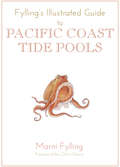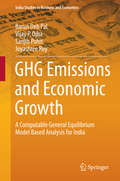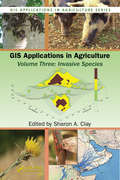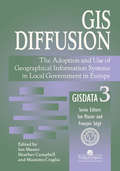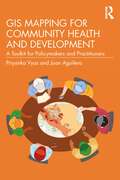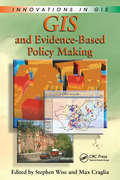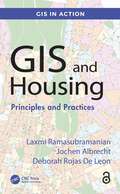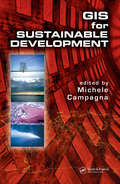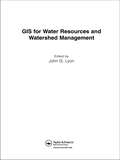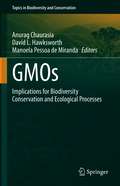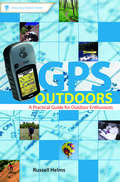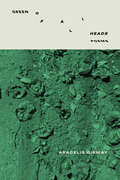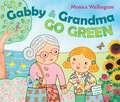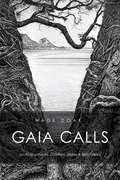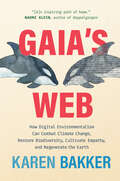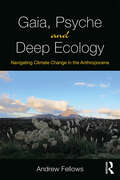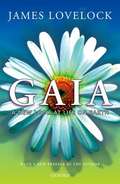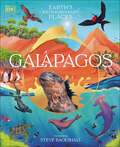- Table View
- List View
Fylling's Illustrated Guide to Pacific Coast Tide Pools (Fylling's Illustrated Guides #1)
by Marni FyllingThis scientifically accurate yet utterly charming field guide to the Pacific coast intertidal zone introduces readers to a world populated by spectacular wildlife: 150-year-old giant green anemones that paralyze their prey with their petal-like tentacles; sunflower sea stars that traverse the tide pool floor on twenty-four limbs; orange-tipped, opalescent sea slugs that dabble in cannibalism; and much, much more. Small enough to fit in a back pocket during a beach hike, the guide contains concise descriptions of tide pools' most common residents, noting each organism's size and zonation, as well as a few of its fascinating (and sometimes grotesque) habits. Full-color illustrations reminiscent of prints by Ernst Haeckel help tide poolers with easy identification.
G. Evelyn Hutchinson and the Invention of Modern Ecology
by Nancy G. SlackStephen J. Gould declared G. Evelyn Hutchinson the most important ecologist of the twentieth century. E.O. Wilson pronounced him "one of the few scientists who could unabashedly be called a genius." In this fascinating book, Nancy G. Slack presents for the first time the full life story of this brilliant scientist who was also a master teacher, a polymath, and a delightful friend and correspondent. Based on full access to Hutchinson's archives and extensive interviews with him and many who knew him, the author evaluates his important contributions to modern ecology and his profound influence as a mentor. Filled with information available nowhere else, the book draws a vibrant portrait of an original scientific thinker who was also a man of remarkable personal appeal.
GHG Emissions and Economic Growth
by Sanjib Pohit Barun Deb Pal Vijay P. Ojha Joyashree RoyIssues linking climate change and economic growth are now at the centre of discussions regarding development strategies especially in the context of developing countries. This book contributes by analyzing the relationship between economic growth and GHG emissions in India with explicit reference to all major economic sectors. One of the most popular tools for macroeconomic policy analysis is Social Accounting Matrix (SAM). The book presents the methods and estimates of the latest Social Accounting Matrix (SAM) for India, which provides a major data base describing the complete circular flow of income and input-output transactions among the sectors of the economy. The novelty of the book lies in the fact that for the first time a SAM has been prepared for the Indian economy with environmental indicators. A detailed methodology for constructing such an extended SAM is also presented in the book. The environmental social accounting matrix (ESAM) based analysis has been included to show direct and indirect links between economic growth and GHG emissions. The book also includes analysis of factors affecting historical GHG emissions trends in India. The book goes beyond SAM and applies computable general equilibrium (CGE) modelling to derive climate-change policy analysis and simulations. This CGE-based analysis is an important contribution to the current debate surrounding carbon tax and its possible impact on macroeconomic growth.
GIFT OF DEER
by Helen HooverIn the farthest wilds of northeastern Minnesota, back in the Gunflint Range, the author of this book and her artist-husband have a two-room cabin home in the bush country. Beginning one Christmas Day when they first watched the starving deer they later named Peter, the Hoovers had many opportunities, a passionate inclination, and the nature skills to observe this whitetail buck--joined later by his mate, and finally by several of their offspring--through the changing seasons of four years. Close as their relationship was to the generations of beautiful animals, the Hoovers did not consider them pets but fellow inhabitants of that wild country. Their observations reveal the rewards of living close to wild creatures; but more than that, they add valuable information to our knowledge of the cycle of life of the deer and other creatures native to the same world. For although the deer are the chief characters of this book, they are by no means the only wild creatures Mrs. Hoover writes of. Her naturalist's eye is just as sharp and her affection just as great for the antics of a curious chickadee or a flying squirrel. Mrs. Hoover's identification with nature knows no favoritism. The Hoovers' world--the bush country of the United States-Canadian border--is farther removed from civilization than "Mr. Emerson's woodlot," but the close relationship of The Gift of the Deer to Walden is evident for all to enjoy. Adrian Hoover's drawings are from life, and they add another level of understanding to his wife's vivid prose.
GIS Applications in Agriculture, Volume Three: Invasive Species (GIS Applications in Agriculture)
by Sharon A. ClayWhile many "alien" plant and animal species are purposefully introduced into new areas as ornamentals, livestock, crops, and even pets, these species can escape into other areas and threaten agricultural and native ecosystems causing economic and environmental harm, or harm to human health. Increasingly, scientists are using Geographic Information Systems (GIS) to track and manage the invaders, mitigate the potential rate of spread and level of impact, and protect the native economy and ecosystem.Beginning with an introduction to the use of GIS technology to capture, store, analyze, manage, and present data, GIS Applications in Agriculture, Volume Three: Invasive Species examines five relevant categories of geographic information including dispersal and transport, prediction and forecasting, mapping of current infestations, maps for management and control tactics, and impact assessment and method of control. It address GIS for studying the population ecology of a new species, niche requirements for species success, and the monitoring and control of several different species including Australian examples of intentionally introduced invasive species, insects and other animals that may also vector a disease, and invasive weed management from prediction to management. Chapters cover maps and imageries available on various Web sites and provide step-by-step tutorials or case studies that allow manipulation of datasets featured on the accompanyingdownloadable resources to make maps, perform statistical analyses, and predict future problems. It offers hands-on experience with a variety of software programs that create interactive queries (user-created searches), analyze spatial information, edit data and maps, and present the results of these operations in several different formats. Some of the programs are freeware, others are not, but each can be used to integrate, edit, share, and display geographic information. Color figures are
GIS Diffusion: The Adoption And Use Of Geographical Information Systems In Local Government in Europe
by Ian Masser; Heather Campbell; Massimo CragliaThis third book in the GISDATA series focuses on the widespread use of geographical information systems GIS in European local government. The editors include a wide range of applications carried out by different professional groups, and offer the opportunity of studying the extent to which diffusion of innovations like GIS are sensitive to national issues such as cultural context, institutional setup and the availability of data.; The book answers key questions such as: what can be learnt from research on organizational behaviour in relation to technological innovation?; what are the classical features of the GIS diffusion process?; to what extent is the adoption and utilization of GIS facilitated - or impeded - by the organizational culture within which it takes place?; and what mechanisms can be applied to enhance the diffusion of GIS? The book covers aspects of diffusion in the following European countries: UK, France, Italy, Poland, Denmark, The Netherlands, Germany, Greece and Portugal.
GIS Mapping for Community Health and Development: A Toolkit for Policymakers and Practitioners
by Priyanka Vyas Juan AguileraThis book explores how maps generated through Geographic Information Systems (GIS) can be used to integrate principles of health equity and environmental justice into community planning and decision-making. To do this, the book puts forward the 3Ps of GIS mapping: People, Place, and Policy. This book demonstrates how different maps reveal different spatial disparities for each topic, providing alternative lens for addressing socio‑cultural, political, or geographical issues. Using a step-by-step approach, and covering the core concepts by which GIS maps can be interpreted, it builds to provide a comprehensive understanding of what a GIS-generated map may tell us, though crucially also what it may not. Featuring illustrated examples throughout, this book is essentially a tool kit to support a nuanced and holistic perspective on community planning.It will appeal to policymakers, planners, and public health consultants, as well as students moving toward this field.
GIS and Evidence-Based Policy Making
by Stephen Wise Max CragliaAlthough much has been written on evidence-based policy making, this is the first volume to address the potential of GIS in this arena. GIS and Evidence-Based Policy Making covers the development of new methodological approaches, emphasizing the identification of spatial patterns in social phenomena. It examines organizational issues, including the
GIS and Housing: Principles and Practices (GIS in Action)
by Laxmi Ramasubramanian Jochen Albrecht Deborah Rojas De LeonGIS and Housing: Principles and Practices discusses one of the challenges that has not been addressed by Geographic Information Science thus far: how can we use GIS to deal with the complex issues underlying the housing crisis? This book provides GIS technicians and analysts with an overview of US housing challenges and examples of how to effectively integrate spatial thinking to address housing policy questions, while simultaneously introducing housing policy analysts to advanced GIS concepts and techniques to create livable neighborhoods that include housing alternatives beyond the single family. Through numerous examples, the authors advocate for a collaborative approach that encourages professionals, policymakers, and analysts, across different ideological and political perspectives, to confront the multifaceted housing crisis. Features: Examines the historical aspects of housing provision, societal attitudes, demographic shifts, and government policies. Bridges the gaps between housing professionals and GIS experts, facilitating an interdisciplinary approach to address the housing crisis. Explores different challenges that are facing urban, suburban, and rural neighborhoods in different US regions. Provides professionals with the necessary tools for informed decision-making. Proposes solutions that leverage the integrative capacity of GIS to address established housing issues. Advocates for denser housing alternatives to address issues of affordability, supply shortages, and homelessness. This book is intended for graduate students and professionals in housing, community development, urban planning, architecture, and GIS, and anyone curious about learning more about the American housing crisis.
GIS for Environmental Decision-Making (Innovations in GIS)
by Andrew Lovett Katy AppletonEnvironmental applications have long been a core use of GIS. However, the effectiveness of GIS-based methods depends on the decision-making frameworks and contexts within which they are employed. GIS for Environmental Decision-Making takes an interdisciplinary look at the capacities of GIS to integrate, analyze, and display data on which decisions
GIS for Sustainable Development
by Michele CampagnaGIS for Sustainable Development examines how GIS applications can improve collaboration in decision making among those involved in promoting sustainable development. This volume reviews leading GIScience, providing an overview of research topics and applications that enable GIS newcomers and professionals to apply GIScience methods to susta
GIS for Water Resource and Watershed Management
by John G. LyonThe use of GIS, and its application for solving environmental problems is growing rapidly. This powerful set of tools can be used to great effect in hydrological modeling, environment and habitat assessments, ecosystem studies, monitoring of wetlands and forested watersheds, urban studies, agricultural impact assessment and much more. GIS for Water
GIS in Sustainable Urban Planning and Management (Open Access): A Global Perspective
by Martin Van Maarseveen Javier Martinez Johannes FlackeThe Open Access version of this book, available at http://www.tandfebooks.com/doi/view/10.1201/9781315146638, has been made available under a Creative Commons Attribution-Non Commercial-No Derivatives 3.0 license. <P><P> GIS is used today to better understand and solve urban problems. GIS in Sustainable Urban Planning and Management: A Global Perspective, explores and illustrates the capacity that geo-information and GIS have to inform practitioners and other participants in the processes of the planning and management of urban regions. The first part of the book addresses the concept of sustainable urban development, its different frameworks, the many ways of measuring sustainability, and its value in the urban policy arena. The second part discusses how urban planning can shape our cities, examines various spatial configurations of cities, the spread of activities, and the demands placed on different functions to achieve strategic objective. It further focuses on the recognition that urban dwellers are increasingly under threat from natural hazards and climate change. <P><P> Written by authors with expertise on the applications of geo-information in urban management, this book showcases the importance of GIS in better understanding current urban challenges and provides new insights on how to apply GIS in urban planning. It illustrates through real world cases the use of GIS in analyzing and evaluating the position of disadvantaged groups and areas in cities and provides clear examples of applied GIS in urban sustainability and urban resilience. <P><P> The idea of sustainable development is still very much central in the new development agenda of the United Nations, and in that sense, it is of particular importance for students from both the Global South and Global North. Professionals, researchers, and students alike will find this book to be an invaluable resource for understanding and solving problems relating to sustainable urban planning and management.
GMOs: Implications for Biodiversity Conservation and Ecological Processes (Topics in Biodiversity and Conservation #19)
by David L. Hawksworth Anurag Chaurasia Manoela Pessoa de MirandaThis book covers a broad spectrum of topics related to GMOs and allied new gene-based technologies, biodiversity, and ecosystem processes, bringing together the contributions of researchers and regulators from around the world. The aim is to offer a clear view of the benefits and effects of genetically modified crops, insects, and other animals on the soil microbiome and ecological processes. Contributors examine issues related to the development of risk assessment procedures and regulations designed to maximize benefits while minimizing risks. Beyond the scientific challenges of GMOs, the book explores the broad and contentious terrain of ethical considerations. The contributors discuss such questions as the unintended, possibly unforeseen, consequences of releasing GMOs into ecosystems, and the likelihood that the full effects of GMOs could take years, even decades, of close monitoring to become evident. The importance of developing a precautionary approach is stressed. The final chapter describes the critical issues of governance and regulation of new and emerging gene-based technologies, as nations grapple with the consequences of adopting the Cartagena Protocol on Biosafety (CPB). The volume includes an extensive Annex which outlines legal perspectives on the state of GMO governance around the world, with more than 20 examples from nations in Africa, South and Central America, Asia, Australasia, and Europe.
GPS Outdoors
by Russell HelmsFor about $150 anyone can access the United States' multi-billion dollar GPS program. Using GPS Outdoors: A Practical Guide for Hikers, Bikers, Paddlers, and Climbers shows readers how to plug in and enhance most any outdoor experience.Whether a hiker on a weekend trip through the Great Smokies, a backpacker cruising the Continental Divide Trail, a mountain biker kicking up dust in Moab, a paddler running the Lewis and Clark bicentennial route, or a climber pre-scouting the routes up Mount Shasta, a simple handheld GPS unit is fun, useful, and can even be a lifesaver.Described in conjunction with today's most popular GPS software, easy to understand information enables readers to:- Plan a trip- Navigate along a route- Gather data from the outing- Analyze trip data after the tripInformation is power, and a GPS unit is today's preferred tool to harness the power of navigational technology for a more enjoyable, more informative, and possibly safer outdoor experience.
GREEN OF ALL HEADS
by Aracelis Girmay*The Whiting Award-winning poet returns*Written over the span of a decade, GREEN OF ALL HEADS is a work of formal range and emotional urgency. In the coinciding wakes of tragic loss and new motherhood, Aracelis Girmay examines the entangled temporalities of an aging parent and newly born children. This vital work grapples with what it means to attend to life in the context of corporate industries of birth and death. In language shaped by these pressures, she turns to what is small, unruly, nationless, plural — flowers, speech — to reach toward new relational and political possibility. Away from the fixed and monumental, and toward that which is fleeting, she writes: “— i am learning to lift — my voice — like a flower — in — a field of flowers —” The result is a language broken and emboldened by love.
Gabby and Grandma Go Green
by Monica WellingtonWhen Gabby and Grandma get together, "Green Day" means "Fun Day." From sewing their own cloth bags and buying vegetables at the Farmers' Market to recycling their bottles, these two know how to have a good time while doing good things for the earth. The illustrations in Monica Wellington's popsicle-bright palette-enhanced with myriad shades of green-result in a perfectly "green" addition to her books for the very young.
Gaia Alchemy: The Reuniting of Science, Psyche, and Soul
by Stephan Harding• Examines how integrating important alchemical images with Gaian science can offer insights into our interconnectedness with Gaia • Looks at how the four components of the living earth--biosphere, atmosphere, hydrosphere, and lithosphere--mesh with the four elements of alchemical theory and the four functions of consciousness as understood by depth psychology • Offers guided meditations and contemplative exercises to open your receptivity to messages from the biosphere and help you connect more deeply with Gaia During the scientific revolution, science and soul were drastically separated, propelling humanity into four centuries of scientific exploration based solely on empiricism and rationality. But, as scientist and ecologist Stephan Harding, Ph.D., demonstrates in detail, by reintegrating science with profound personal experiences of psyche and soul, we can reclaim our lost sacred wholeness and help heal ourselves and our planet. Harding begins with compelling introductions to depth psychology, alchemy, and Gaia theory--the science of seeing the Earth as an intelligent, self-regulating system, a theory pioneered by his mentor James Lovelock. He then explores how alchemy, as understood through the depth psychology of C. G. Jung, offers us powerful methods of reuniting rationality and intuition, science and soul. He examines the integration of important alchemical engravings, including L&’Azoth des Philosophes and the Rosarium Philosophorum, with Gaian science. He shows how the seven key alchemical operations in the Azoth image can help us develop deeply transformative experiences and insights into our interconnectedness with Gaia. He then looks at how the four components of the living Earth--biosphere, atmosphere, hydrosphere, and lithosphere--mesh not only with the four elements of alchemical theory but also with the four functions of consciousness from depth psychology. Woven throughout with the author&’s own experiences of Gaia alchemy, the book also offers guided meditations, shamanic practices, and contemplative exercises to open your receptivity to messages from the biosphere and help you develop your own Gaia alchemical way of life, full of wonder and healing.
Gaia Calls
by Wade DoakWade Doak is one of the world's leading marine explorers. In Gaia Calls he takes his readers on a unforgettable journey. From his first discovery of the sunken treasure of the Elingamite, to life as a young man in the Solomon Islands living among the islanders, to years of dolphin research, diving adventures, and his discovery of interspecies communication. With patience, focus, and respect he shares his knowledge and love for the natural world, and leads his readers to a deeper understanding of the interconnectedness of all life. A fascinating and engaging document of a life well lived.
Gaia in Turmoil: Climate Change, Biodepletion, and Earth Ethics in an Age of Crisis
by Eileen Crist H. Bruce RinkerEssays link Gaian science to such global environmental quandaries as climate change and biodiversity destruction, providing perspectives from science, philosophy, politics, and technology. Gaian theory, which holds that Earth's physical and biological processes are inextricably bound to form a self-regulating system, is more relevant than ever in light of increasing concerns about global climate change. The Gaian paradigm of Earth as a living system, first articulated by James Lovelock and Lynn Margulis in the 1970s, has inspired a burgeoning body of researchers working across disciplines that range from physics and biology to philosophy and politics. Gaia in Turmoil reflects this disciplinary richness and intellectual diversity, with contributions (including essays by both Lovelock and Margulis) that approach the topic from a wide variety of perspectives, discussing not only Gaian science but also global environmental problems and Gaian ethics and education. Contributors focus first on the science of Gaia, considering such topics as the workings of the biosphere, the planet's water supply, and evolution; then discuss Gaian perspectives on global environmental change, including biodiversity destruction and global warming; and finally explore the influence of Gaia on environmental policy, ethics, politics, technology, economics, and education. Gaia in Turmoil breaks new ground by focusing on global ecological problems from the perspectives of Gaian science and knowledge, focusing especially on the challenges of climate change and biodiversity destruction. Contributors David Abram, Donald Aitken, Connie Barlow, J. Baird Callicott, Bruce Clarke, Eileen Crist, Tim Foresman, Stephan Harding, Barbara Harwood, Tim Lenton, Eugene Linden, Karen Litfin, James Lovelock, Lynn Margulis, Bill McKibben, Martin Ogle, H. Bruce Rinker, Mitchell Thomashow, Tyler Volk, Hywel Williams
Gaia's Web: How Digital Environmentalism Can Combat Climate Change, Restore Biodiversity, Cultivate Empathy, and Regenerate the Earth
by Karen BakkerA riveting exploration of one of the most important dilemmas of our time: will digital technology accelerate environmental degradation, or could it play a role in ecological regeneration?At the uncanny edge of the scientific frontier, Gaia&’s Web explores the promise and pitfalls the Digital Age holds for the future of our planet. Instead of the Internet of Things, environmental scientist and tech entrepreneur Karen Bakker asks, why not consider the Internet of Living Things? At the surprising and inspiring confluence of our digital and ecological futures, Bakker explores how the tools of the Digital Age could be mobilized to address our most pressing environmental challenges, from climate change to biodiversity loss. Interspersed with ten elegiac, enigmatic parables, each of which is based on an existing technology, Gaia&’s Web evokes the conundrums we face as the World Wide Web intertwines with the Web of Life.A new generation of innovators is deploying digital technology to come to the aid of the planet, using spy satellites to track down environmental criminals, inviting animals to the Metaverse, and biohacking Frankenstein-like biobots as environmental sentinels. But will they end up doing more harm than good? In an engaging take on conservation technology, Bakker looks at the digital tech applications to environmental issues from predatory harvesting of environmental data to human bycatch and eco-surveillance capitalism. If we address these issues and mobilize digitally mediated forms of citizen science, she argues, digital tech could help reverse environmental harms and advance environmental sustainability. And in the process, Big Tech might be transformed for the better.With its uniquely broad scope—combining insights from computer science, ecology, engineering, environmental science, and environmental law—Gaia&’s Web introduces profoundly novel ways of addressing our most pressing environmental challenges—mitigating climate change, protecting endangered species—and creating new possibilities for ecological justice by empowering nonhumans to participate in environmental regulation.
Gaia, Psyche and Deep Ecology: Navigating Climate Change in the Anthropocene
by Andrew FellowsWinner of the Scientific & Medical Network Book Prize 2019! In Gaia, Psyche and Deep Ecology: Navigating Climate Change in the Anthropocene, Andrew Fellows uniquely connects Earth systems, Jungian and philosophical approaches to the existential threats that we face today. He elucidates the psychological basis of our dysfunctional relationship with nature, thereby offering a coherent framework for transforming this in our personal and professional lives. Demonstrating the imperative for new ideas that transcend the status quo, Fellows tackles unprecedented 21st century challenges such as climate change through his interdisciplinary approach. Fellows proposes a worldview, informed by depth psychology, which radically contradicts the prevailing shibboleths of unlimited economic growth, dominion over outer nature and negation of our inner nature. To accommodate a broad readership, he first introduces the Anthropocene and sufficient basics of systems dynamics, Gaia theory and analytical psychology before exploring the mind-matter conundrum. He then correlates the structure, dynamics, contents and pathology of Gaia and of psyche, critiques the Western Zeitgeist as midlife crisis and establishes parallels between deep ecology and psychological individuation. This ground-breaking synthesis of Gaia theory, analytical psychology and deep ecology reveals synergies which show how we can, and why we must, relinquish anthropocentrism in order to survive sustainably as equals in and with the natural world. Combining Jungian theory with other cutting-edge disciplines to inform, inspire and heal, this book is essential reading not only for Jungian analysts, students and scholars, but for all—including professionals in Earth systems science, environmental philosophy and ecopsychology—who realise that ‘business as usual’ is no longer an option.
Gaia: A New Look at Life on Earth
by James LovelockIn this classic work that continues to inspire its many readers, James Lovelock deftly explains his idea that life on earth functions as a single organism. Written for the non-scientist, Gaia is a journey through time and space in search of evidence with which to support a new and radically different model of our planet. In contrast to conventional belief that living matter is passive in the face of threats to its existence, the book explores the hypothesis that the earth's living matter-air, ocean, and land surfaces-forms a complex system that has the capacity to keep the Earth a fit place for life. Since Gaia was first published, many of Jim Lovelock's predictions have come true, and his theory has become a hotly argued topic in scientific circles. Here, in a new Preface, Lovelock outlines his present state of the debate.
Gaining Ground: A Story of Farmers' Markets, Local Food, and Saving the Family Farm
by Forrest PritchardWith humor and pathos, Forrest Pritchard recounts his ambitious and often hilarious endeavors to save his family’s seventh-generation farm in the Shenandoah Valley. Through many a trial and error, he not only saves Smith Meadows from insolvency but turns it into a leading light in the sustainable, grass-fed, organic farm-to-market community. There is nothing young Farmer Pritchard won’t try. Whether he’s selling firewood and straw, raising free-range chickens and hogs, or acquiring a flock of Barbados Blackbelly sheep, his learning curve is steep and always entertaining. Pritchard’s world crackles with colorful local characters—farm hands, butchers, market managers, customers, fellow vendors, pet goats, policemen—bringing the story to warm, communal life. His most important ally, however, is his renegade father, who initially questions his son's career choice and eschews organic foods for the generic kinds that wreak havoc on his health. Soon after his father’s death, the farm becomes a recognized success and Pritchard must make a vital decision: to continue serving the local community or answer the exploding demand for his wares with lucrative Internet sales and shipping deals. More than a charming story of honest food cultivation and farmers’ markets, Gaining Ground tugs on the heartstrings, reconnecting us to the land and the many lives that feed us.
Galapagos
by DKLearn all about one of the most unique places on the planet, the Galápagos islands, in this beautifully illustrated children&’s book.This is the ultimate book about the Galápagos for kids, covering the formation of the islands, the fascinating animals that live there, the evolutionary traits of the flora, the diverse climates, the brilliant conservation efforts and much more!This beautifully illustrated and photographic book provides a fascinating tour of the flora, fauna, and geology of the Galapágos islands. Children can learn about the unique and incredible wildlife, volcanoes, climate and Darwin&’s theory of evolution from his visit to the Galápagos. This educational book for children aged 7-11 features:- Pages on geology, evolution, flora and fauna – everything that makes the Galápagos islands incredible and unique- Educational content surrounding the Galapagos islands&’ conservation efforts, endemic species, incredible animals, evolution, geology, migration and much more- Beautiful and unique illustrations paired with expert-written textThe Galapágos islands is one of the most stunning, biologically diverse, nature-rich places on Earth – and this book covers everything that makes them one of the most unique places on the planet.
